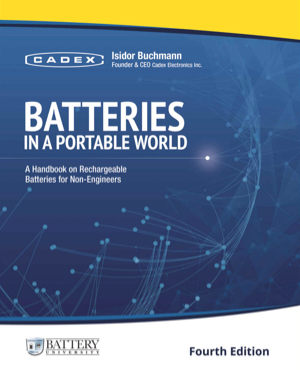Learn about CCA characteristics and capacity fade and how they diverge with age
All batteries age and the effects manifest themselves in diminished capacity, increased internal resistance and elevated self-discharge. A new battery (Figure 1) delivers (or should deliver) 100 percent capacity; an aged unit (Figure 2) may hold only 20 percent. In our example, the capacity loss is illustrated by placing rocks in the container.
.jpg) | Figure 1: New Battery has 100% capacity [1] Capacity is represented by a liquid with no obstruction. The battery delivers full runtime. |
.jpg) | Figure 2: Faded Battery [1] Capacity loss is illustrated as “rock-content.” The battery behaves normally but it has a short runtime, even if fully charged. |
Automotive technicians are most familiar with CCA (cold cranking amps) in relation to turn the engine. CCA relates to the internal battery resistance and the ability to deliver high load current. Figure 3 illustrates a starter battery with high CCA and an open tap symbolizing delivering full power; Figure 4 has elevated internal resistance that limits the current delivery to a trickle.
.jpg)
| Figure 3: Low internal resistance enables high current [1] Cranking current on a starter battery is 300A; a golf car draws 56A |
.jpg)
| Figure 4: Battery with low CCA [1] Rising internal resistance inhibits power delivery. This is less common as capacity fade occurs first. |
Rechargeable batteries have improved and maintain low internal resistance during most of the service life; an increase in internal resistance may only occur towards the very end. Starter batteries keep a high CCA and provide healthy cranking to the end, but the capacity gradually drops without sign. An analogy is a galloping horse that keeps its spirited performance until its eventual collapse from exhaustion. Figure 5 demonstrates the relationship of capacity and CCA of 20 aging starter batteries, sorted according to capacity(See also BU-905a: Testing Starter Batteries in Vehicles)
.jpg)
Batteries 1–9 have good CCA and high capacity; the CCA of batteries 10–20 still enables good cranking, but the batteries have large capacity loss. CCA tends to remain high while the capacity drops with aging. Test method: CCA was estimated with the Spectro CA-12 and the capacity was measured with an Agilent load bank by applying full discharges according to BCI standards.
Batteries 1–9 perform well on capacity and CCA, but batteries 10–20 show notable capacity loss while maintaining acceptable CCA performance. Capacity depletion eventually disables the cranking. This is mostly evident during cold spells, which further reduce the capacity.
Car manufacturers often use 65 percent as the pass/fail threshold for warranty replacement while service garages take 40 percent as an end-of-life indication(See BU-904: How to Measure Capacity) Forty percent should give another 6–12 months of service, but below this is cause for concern and the battery should be replaced even though the cranking is still good. Thrifty drivers (including the author), prefer to wait but invariably get caught with a dead battery at the worst possible moment.
To study the correlation between capacity and internal resistance, Cadex tested 175 aging starter batteries by measuring the CCA and capacity according to SAE J537. In this lengthy test, Cadex found that the correlation between capacity and CCA is only 0.55 (1 would be a perfect match). This led to the development of capacity estimation technology, as relying on the internal resistance, or CCA on a starter battery is unreliable. Figure 6 demonstrates the aging trend of starter batteries as a function of capacity and CCA(See BU-1101: Glossary under SAE J537)

Batteries in the green PASS field are functional; the red FAIL field denotes breakdown. Most batteries exit life through the 40% capacity line at the left field; few slip through the 50% CCA line. Test method: Capacity and CCA were tested accoding to SAE J537.
The horizontal X-axis represents capacity; the vertical Y-axis shows CCA; the stars are the 175 batteries tested. The arrow shows the typical aging trend of batteries passing through the “Capacity Line” on the left PASS field. Very few batteries slip through the “CCA Line.”
This demonstrates that starter batteries fail mainly due to capacity fade rather than low CCA or elevated internal resistance. This characteristic is visible with most lead- and lithium-based batteries. A capacity measurement is more meaningful than measuring the internal resistance, but estimating capacity on the fly involves higher complexities than simply taking an ohmic reading.
References
[1]Courtesy of Cadex

Looking for comments from the previous website?
Comments from the previous website are not compatible with our new commenting system but we have preserved them so our users can still reference and make use the information in them.

My 6 year old AGM start/stop battery is doing the opposite. It has CCA fade but still has lots of capacity. It’s down to 400 cca from 680 cca. High internal resistance. Sounds quite sluggish on cool mornings but you could leave lights etc on and it won’t flatten. Is that a characteristic of AGM’s versus flooded?